
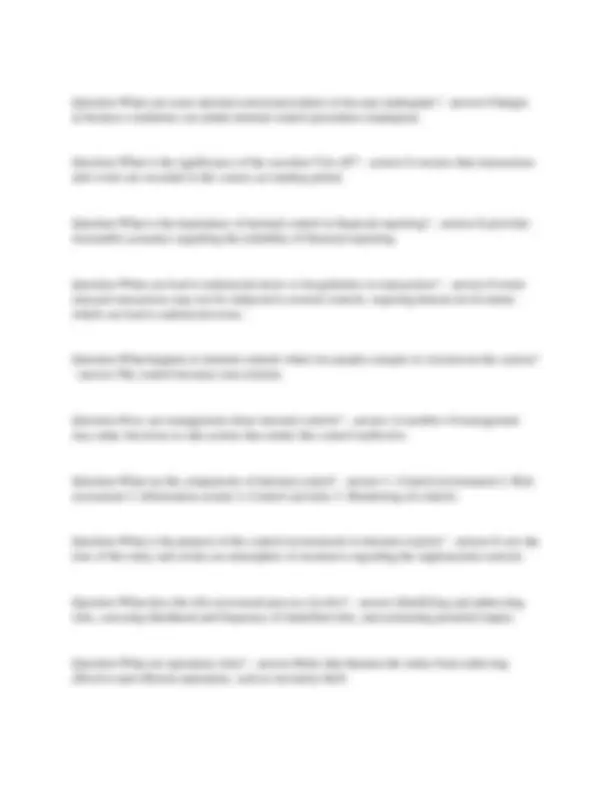
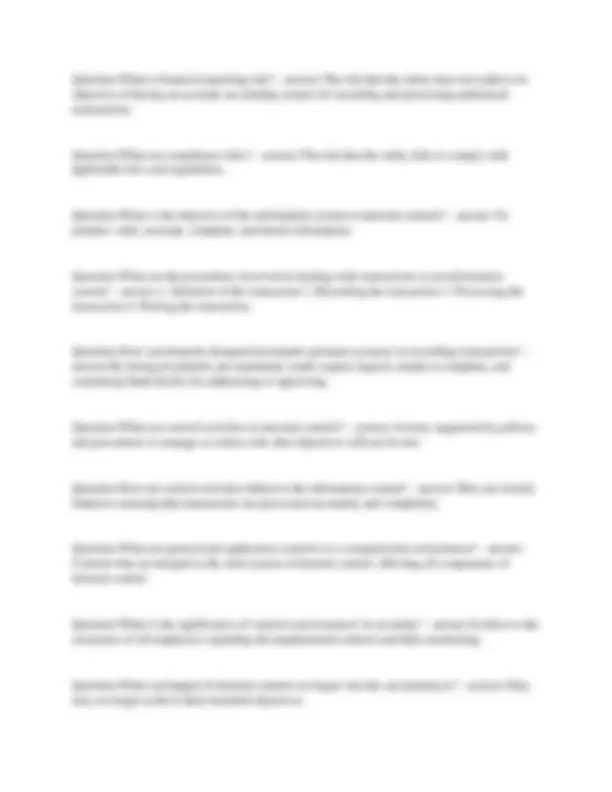
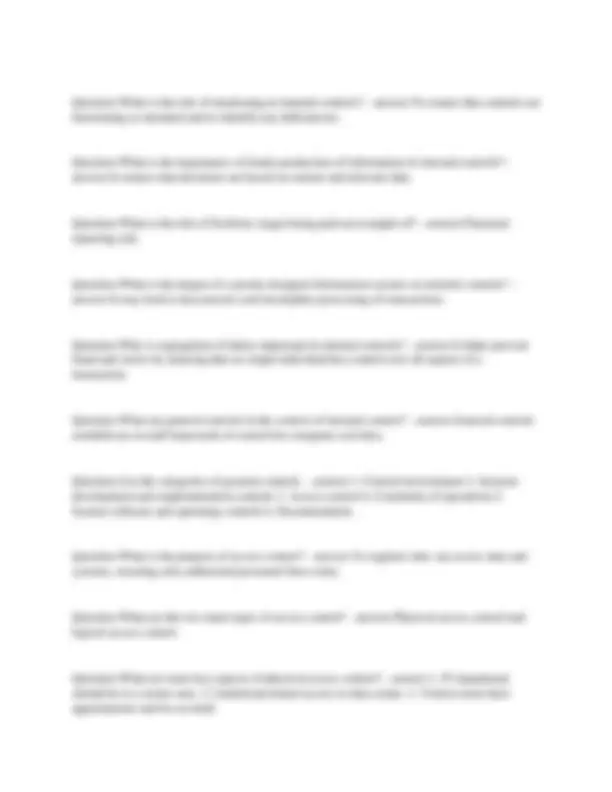
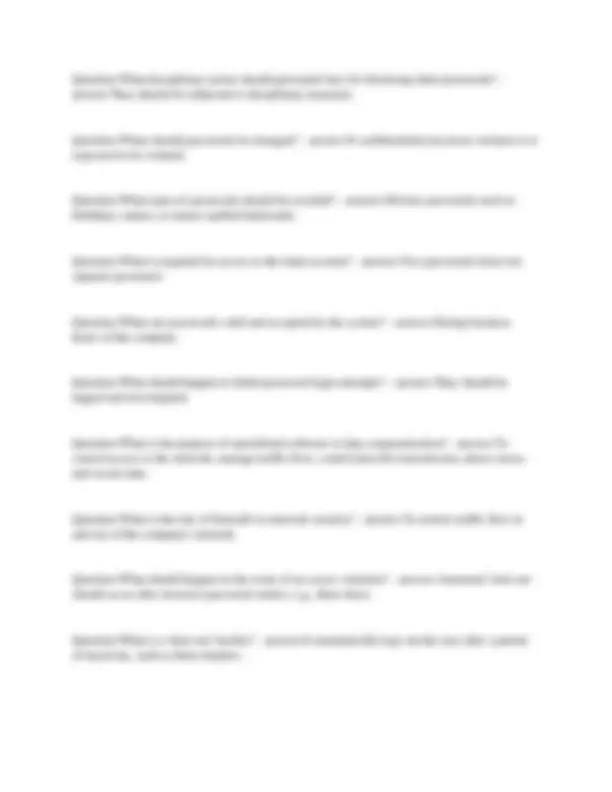
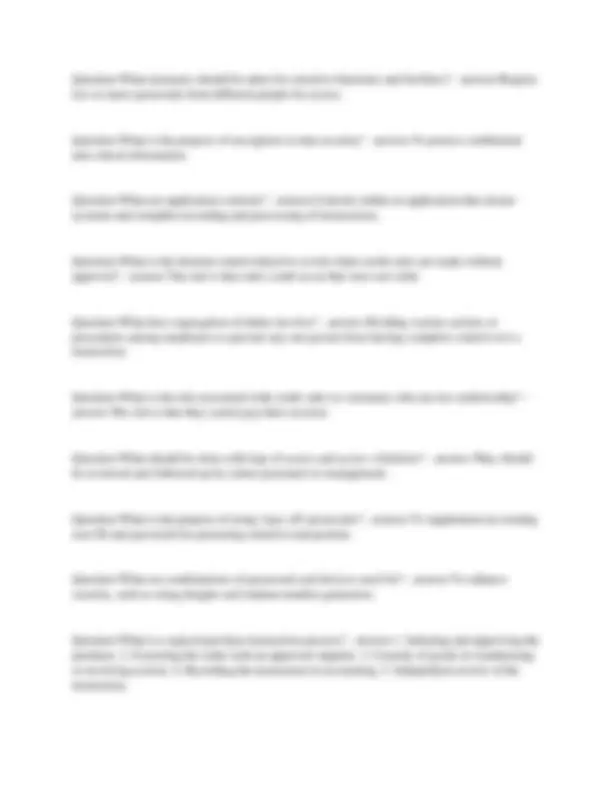
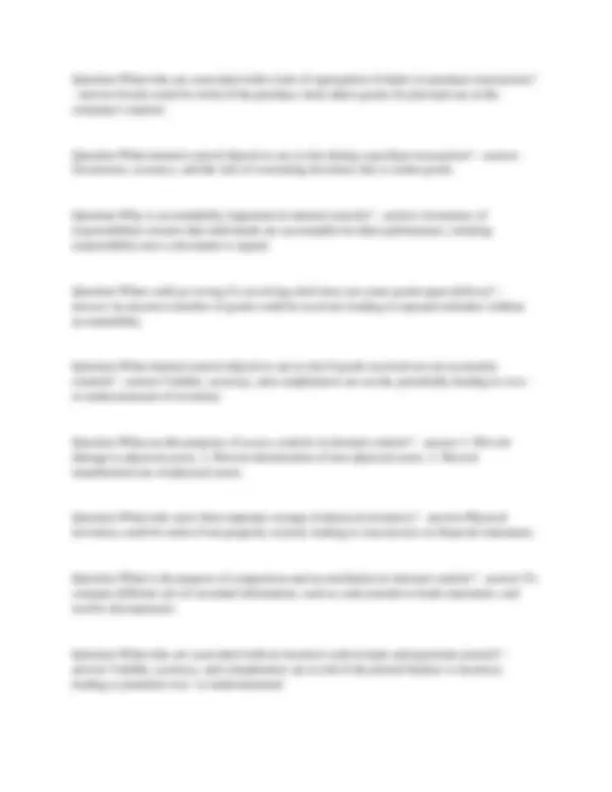
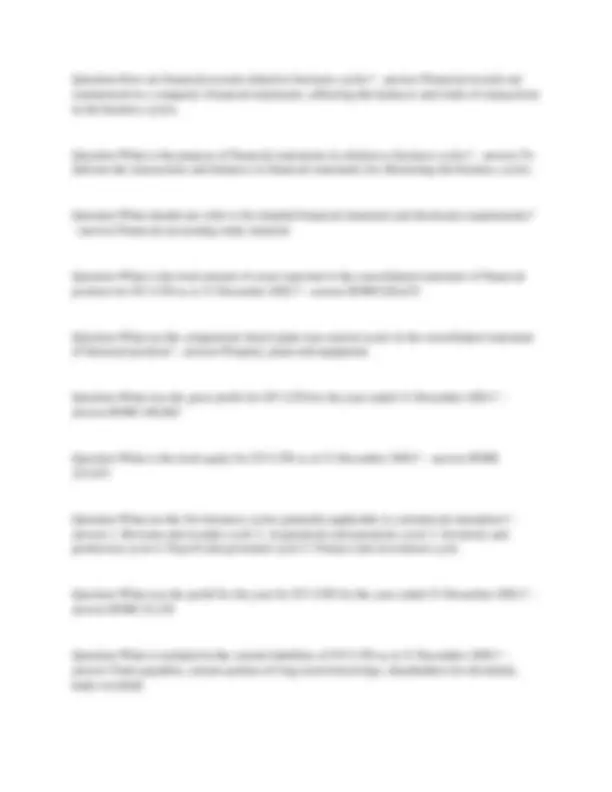
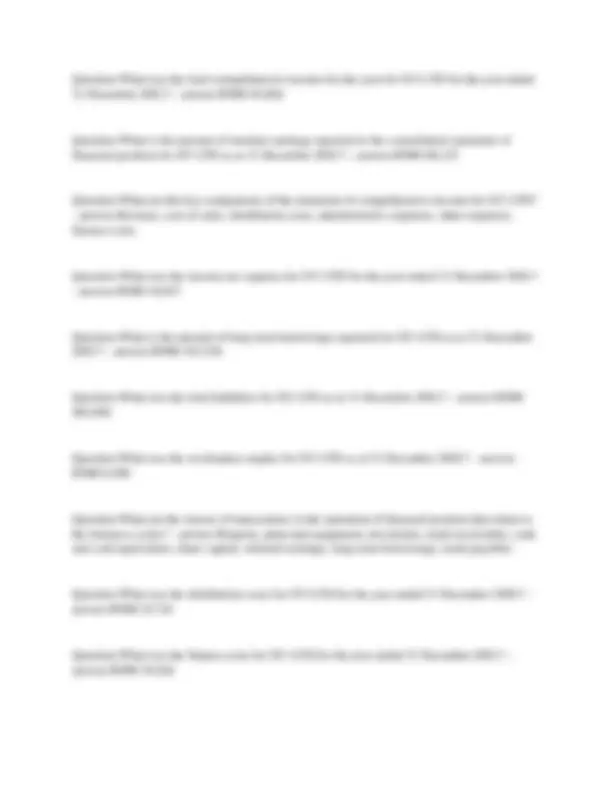
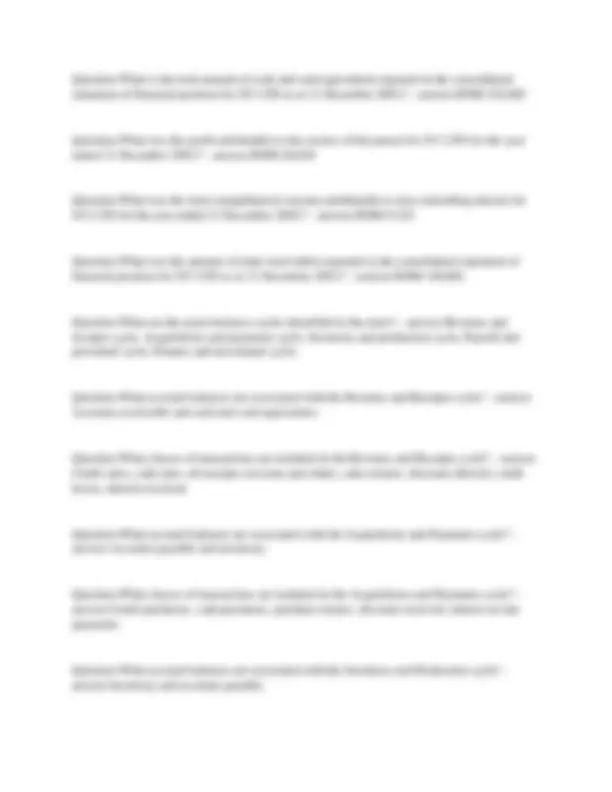
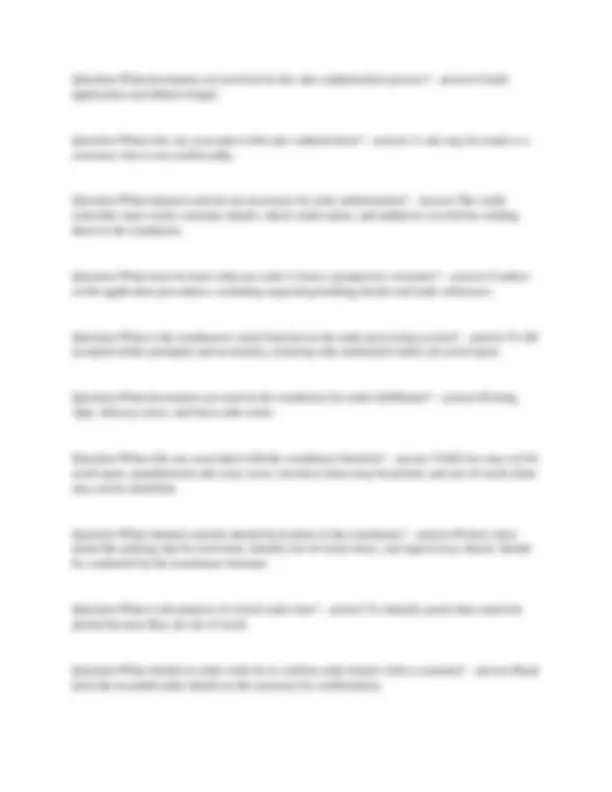
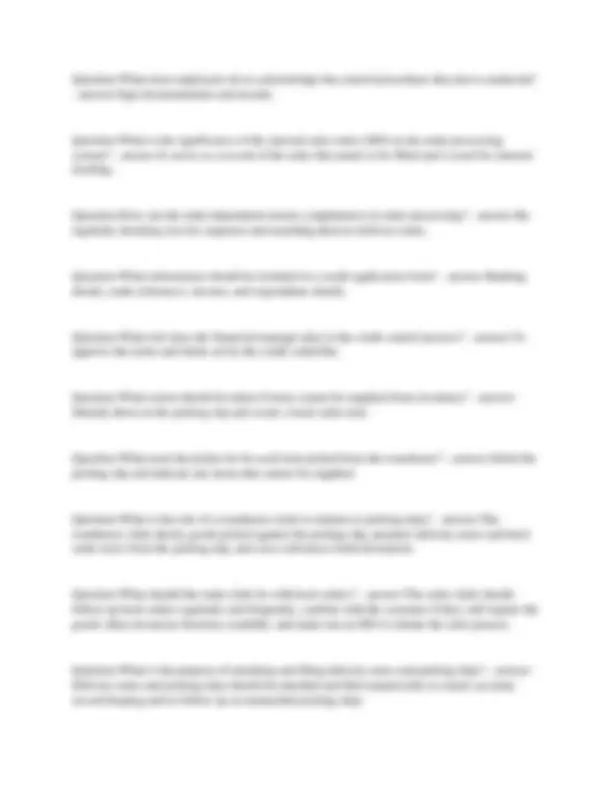
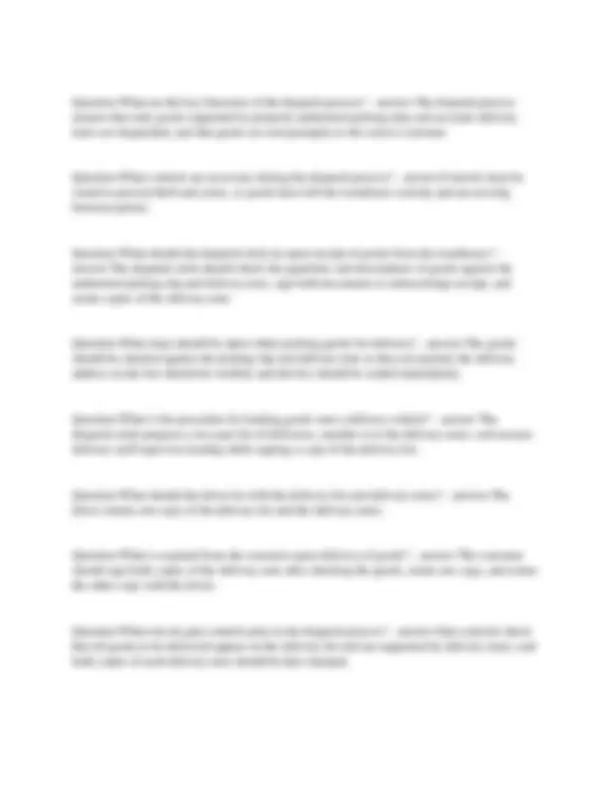
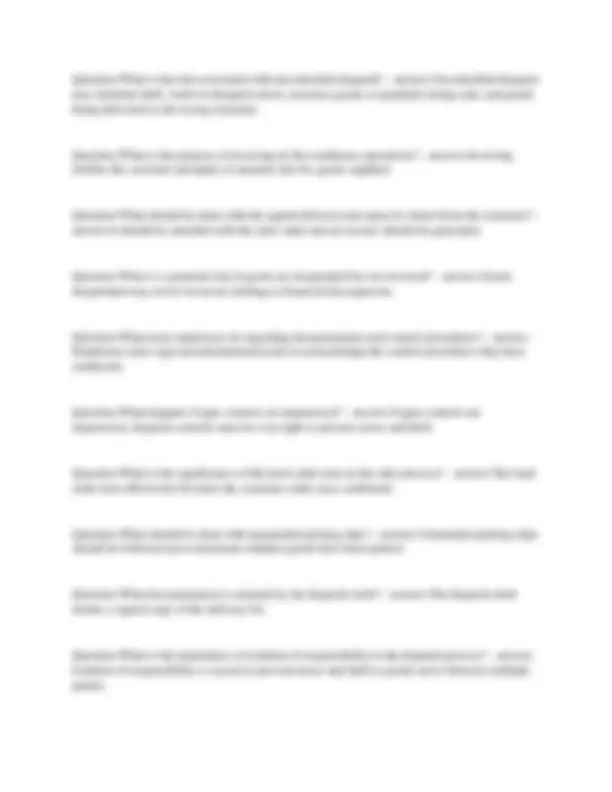
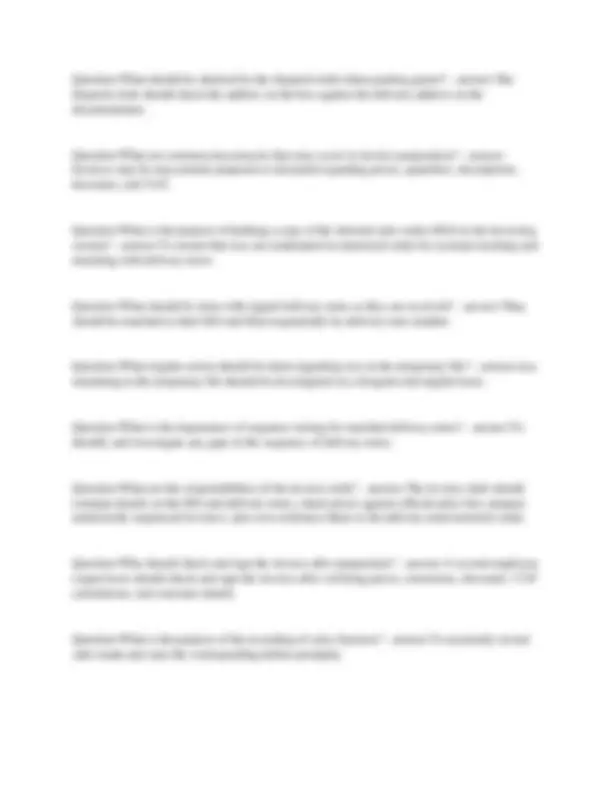
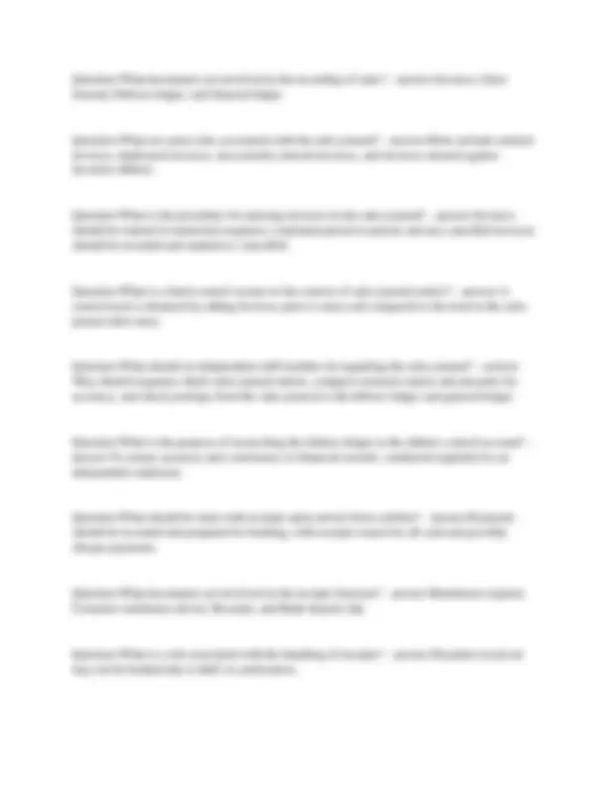
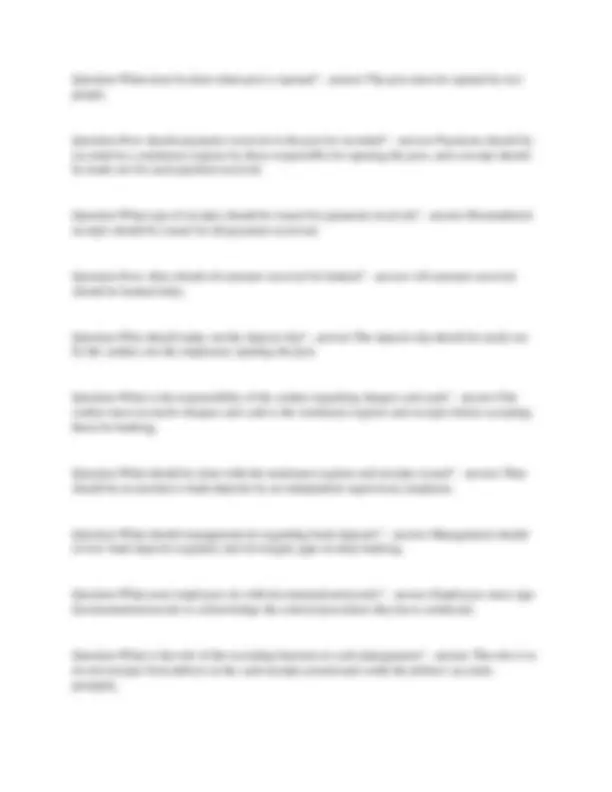
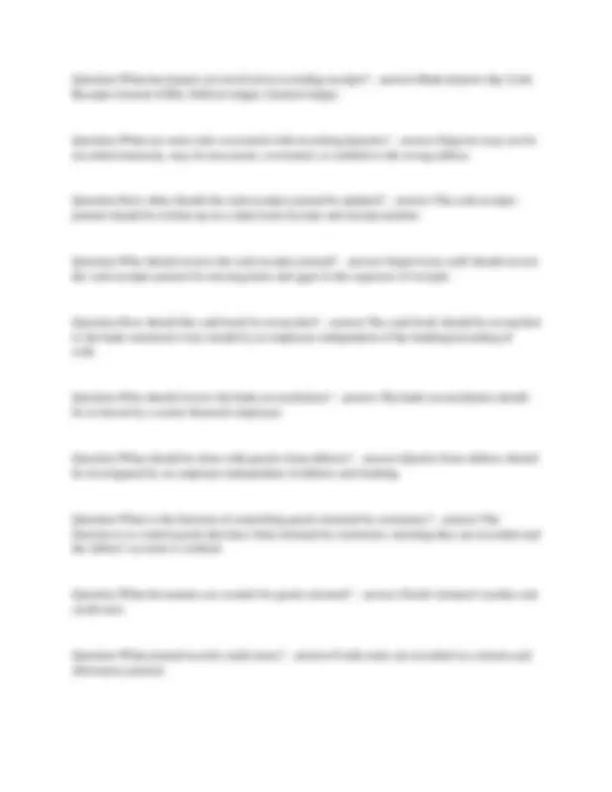
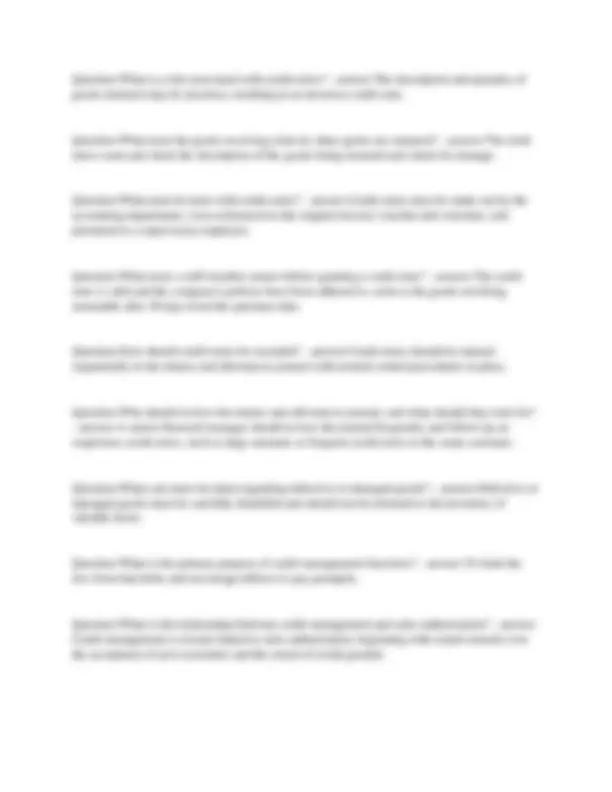
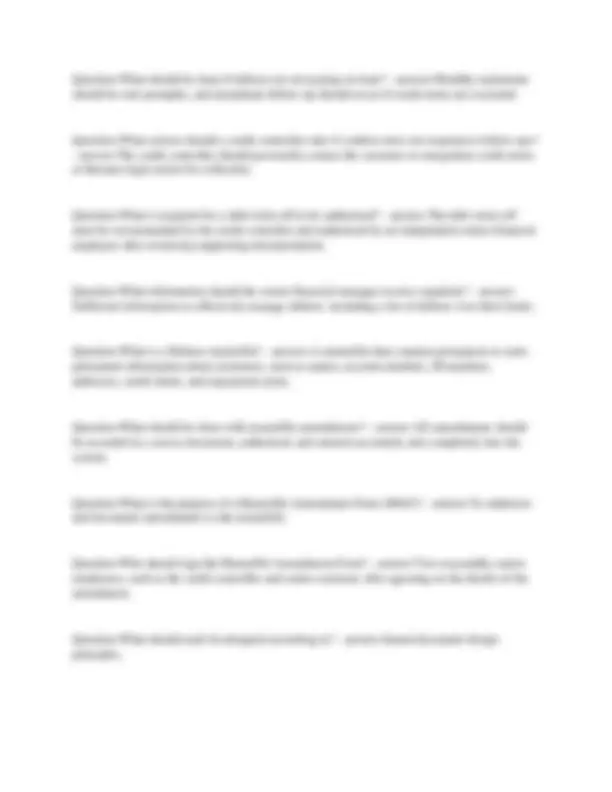
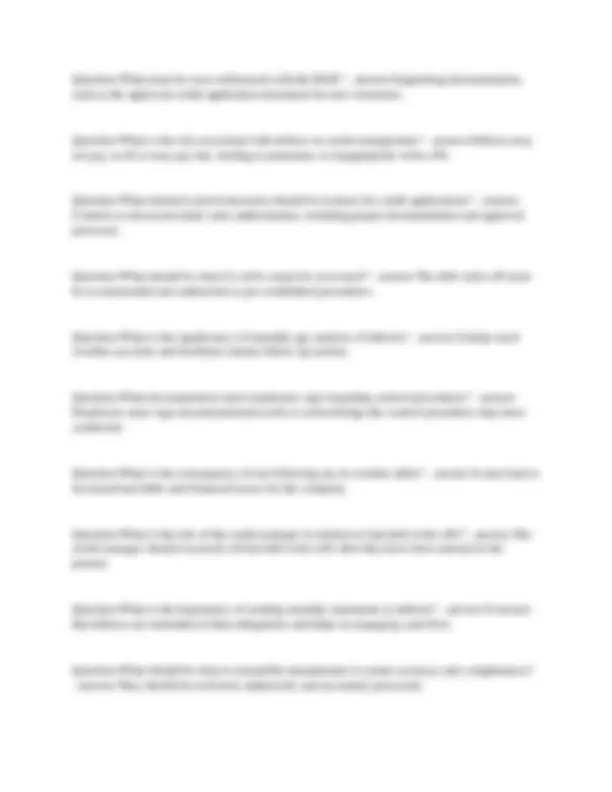
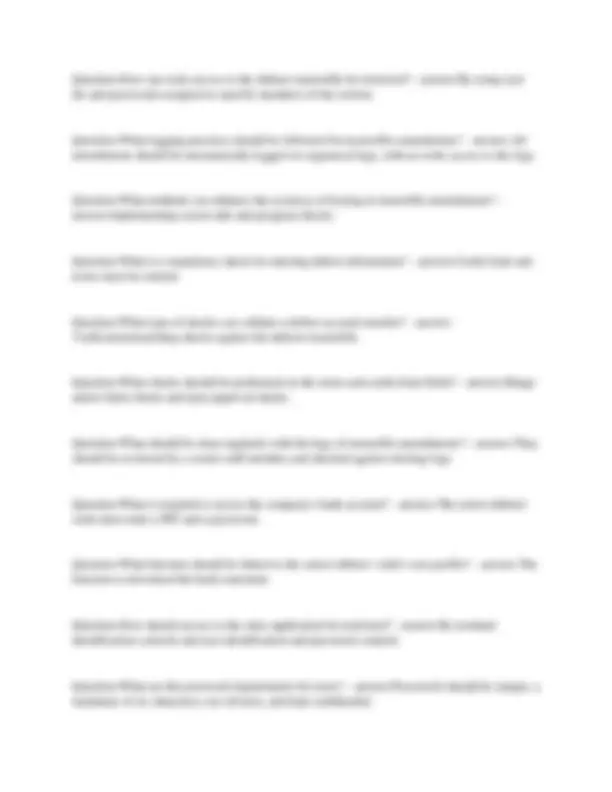
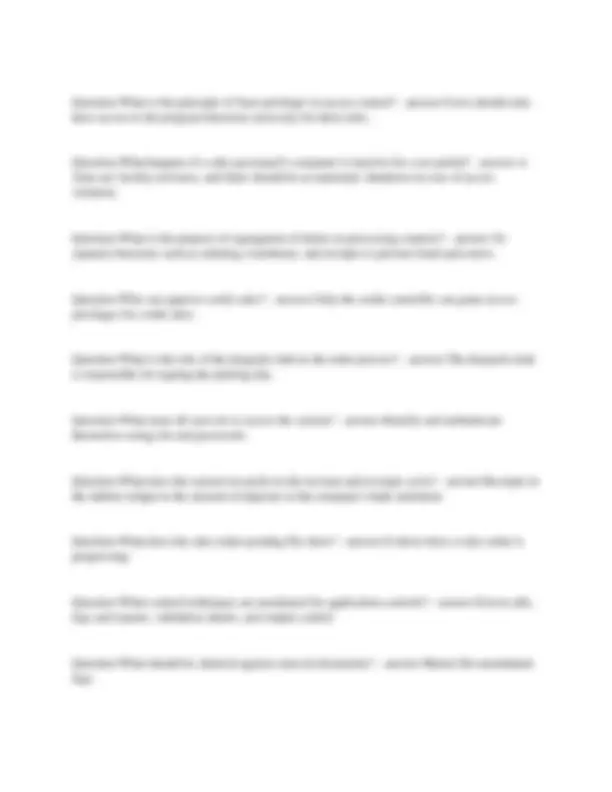
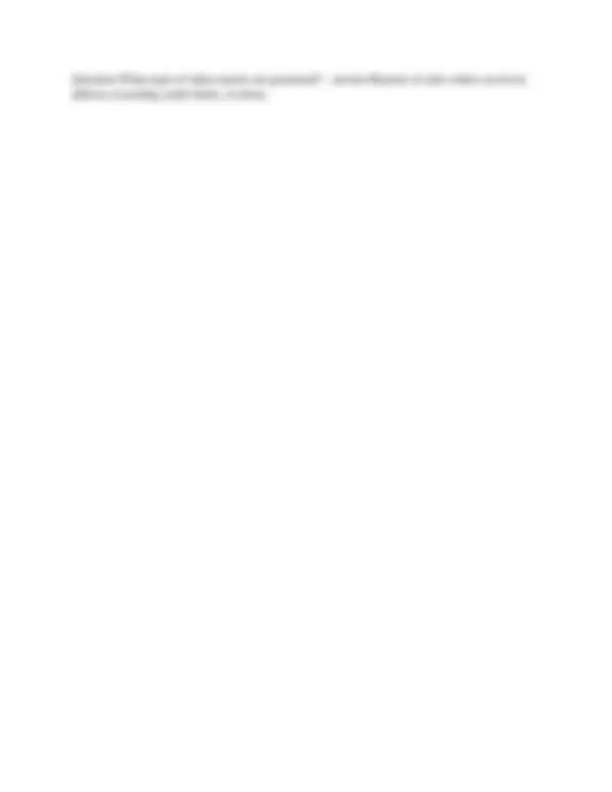


Study with the several resources on Docsity

Earn points by helping other students or get them with a premium plan


Prepare for your exams
Study with the several resources on Docsity

Earn points to download
Earn points by helping other students or get them with a premium plan
Community
Ask the community for help and clear up your study doubts
Discover the best universities in your country according to Docsity users
Free resources
Download our free guides on studying techniques, anxiety management strategies, and thesis advice from Docsity tutors
AUE2602 LATEST EXAM WITH VERIFIED QUESTIONS AND DETAILED ANSWERS FOR GUARANTEED PASS.pdf
Typology: Exams
1 / 31

This page cannot be seen from the preview
Don't miss anything!
























Question-What level of assurance does internal control provide? - answer-It provides reasonable assurance that risks threatening business objectives will be managed. Question-Can a single control address a single risk? - answer-No, internal control requires a combination of actions, policies, and procedures. Question-What are management assertions? - answer-Representations about the company's assets, equity, liabilities, transactions, and events in financial reports. What is internal control? - answer-A process involving systems, policies, and procedures designed to address business risks. Question-Who is responsible for internal control in an organization? - answer-Responsibility is shared among directors, management, and employees. Question-Is internal control static? - answer-No, it is a dynamic response to changing risks in business operations. Question-What is the relationship between internal control objectives and assertions? - answer- Internal control objectives are linked to assertions that validate the reliability of financial reporting. Question-What does the assertion 'Occurrence' refer to? - answer-It confirms that a recorded transaction or event took place and pertains to the entity.
Question-What does the assertion 'Existence' indicate? - answer-It indicates that assets, liabilities, and equity interests exist at a given date. Question-What does the assertion 'Completeness' ensure? - answer-It ensures that all assets, liabilities, transactions, or events have been recorded. Question-What does the assertion 'Accuracy' relate to? - answer-It relates to the appropriate recording of amounts and data for transactions and events. Question-What does the assertion 'Classification' ensure? - answer-It ensures that transactions and events are recorded in the proper accounts. Question-What does the assertion 'Rights and Obligations' signify? - answer-It signifies that the entity holds rights to assets and liabilities are its obligations. Question-What does 'Valuation and Allocation' refer to? - answer-It refers to the appropriate inclusion of assets, liabilities, and equity in financial statements. Question-What is a limitation of internal controls regarding cost? - answer-Internal controls must be cost-effective; the cost should not exceed the expected benefit. Question-What is a limitation of internal controls concerning routine transactions? - answer- Internal controls emphasize routine transactions over non-routine ones, which may increase risk. Question-What human factor can limit internal controls? - answer-Human error due to carelessness, distraction, or misunderstanding can limit effectiveness. Question-What is the risk of collusion in internal controls? - answer-Collusion can undermine controls that depend on segregation of duties. Question-How can management override internal controls? - answer-A member of management may override a control for which they are responsible.
Question-What is financial reporting risk? - answer-The risk that the entity does not achieve its objective of having an accurate accounting system for recording and processing authorized transactions. Question-What are compliance risks? - answer-The risk that the entity fails to comply with applicable laws and regulations. Question-What is the objective of the information system in internal controls? - answer-To produce valid, accurate, complete, and timely information. Question-What are the procedures involved in dealing with transactions in an information system? - answer-1. Initiation of the transaction 2. Recording the transaction 3. Processing the transaction 4. Posting the transaction. Question-How can properly designed documents promote accuracy in recording transactions? - answer-By being pre-printed, pre-numbered, multi-copied, logical, simple to complete, and containing blank blocks for authorizing or approving. Question-What are control activities in internal controls? - answer-Actions supported by policies and procedures to manage or reduce risks that objectives will not be met. Question-How are control activities linked to the information system? - answer-They are closely linked to ensuring that transactions are processed accurately and completely. Question-What are general and application controls in a computerized environment? - answer- Controls that are integral to the total system of internal control, affecting all components of internal control. Question-What is the significance of 'control consciousness' in an entity? - answer-It refers to the awareness of all employees regarding the implemented controls and their monitoring. Question-What can happen if internal controls no longer suit the circumstances? - answer-They may no longer achieve their intended objectives.
Question-What is the role of monitoring in internal controls? - answer-To ensure that controls are functioning as intended and to identify any deficiencies. Question-What is the importance of timely production of information in internal controls? - answer-It ensures that decisions are based on current and relevant data. Question-What is the risk of fictitious wages being paid an example of? - answer-Financial reporting risk. Question-What is the impact of a poorly designed information system on internal controls? - answer-It may lead to inaccuracies and incomplete processing of transactions. Question-Why is segregation of duties important in internal controls? - answer-It helps prevent fraud and errors by ensuring that no single individual has control over all aspects of a transaction. Question-What are general controls in the context of internal control? - answer-General controls establish an overall framework of control for computer activities. Question-List the categories of general controls. - answer-1. Control environment 2. Systems development and implementation controls 3. Access control 4. Continuity of operations 5. System software and operating controls 6. Documentation. Question-What is the purpose of access control? - answer-To regulate who can access data and systems, ensuring only authorized personnel have entry. Question-What are the two main types of access control? - answer-Physical access control and logical access control. Question-What are some key aspects of physical access control? - answer-1. IT department should be in a secure area. 2. Limited personnel access to data center. 3. Visitors must have appointments and be escorted.
Question-What is the importance of documentation in general controls? - answer-Documentation provides a record of controls and procedures, ensuring consistency and accountability. Question-What is continuity of operations in the context of general controls? - answer-It refers to planning and preparing for potential disruptions to ensure ongoing operations. Question-What are the implications of segregation of duties in application controls? - answer-It helps prevent fraud and errors by ensuring that no single individual has control over all aspects of a transaction. Question-What does approval and authorization entail in application controls? - answer-It requires that transactions are reviewed and approved by designated individuals before processing. Question-What is the purpose of comparison and reconciliation in monitoring? - answer-To verify that records are accurate and consistent across different systems or reports. Question-What are some supplementary access control considerations? - answer-These may include additional security measures such as visitor logs and security personnel presence. Question-What should be done to protect data cables? - answer-They should be secured to prevent tapping and unauthorized access to the system. Question-What should a new employee be prompted to do upon first accessing the system? - answer-Change their initial password. Question-What should not be displayed on pcs or printed on reports? - answer-Passwords. Question-What should be implemented to protect password files? - answer-Strict access controls to prevent unauthorized read and write access.
Question-What disciplinary action should personnel face for disclosing their passwords? - answer-They should be subjected to disciplinary measures. Question-When should passwords be changed? - answer-If confidentiality has been violated or is expected to be violated. Question-What types of passwords should be avoided? - answer-Obvious passwords such as birthdays, names, or names spelled backwards. Question-What is required for access to the bank account? - answer-Two passwords from two separate personnel. Question-When are passwords valid and accepted by the system? - answer-During business hours of the company. Question-What should happen to failed password login attempts? - answer-They should be logged and investigated. Question-What is the purpose of specialized software in data communication? - answer-To control access to the network, manage traffic flow, control data file transmission, detect errors, and secure data. Question-What is the role of firewalls in network security? - answer-To restrict traffic flow in and out of the company's network. Question-What should happen in the event of an access violation? - answer-Automatic lock-out should occur after incorrect password entries, e.g., three times. Question-What is a 'time-out' facility? - answer-It automatically logs out the user after a period of inactivity, such as three minutes.
Question-What risks are associated with a lack of segregation of duties in purchase transactions?
Question-What is the role of performance reviews in internal controls? - answer-Performance reviews help identify problems by looking for consistency and reasonableness in operations. Question-What could go undetected if management fails to compare actual costs with budgeted costs? - answer-An abnormal increase in transport costs due to theft, such as fuel theft, could go undetected. Question-What are preventative controls in internal controls? - answer-Controls designed to minimize errors or illegal events from occurring, including physical custody controls and segregation of duties. Question-What are detective controls in internal controls? - answer-Controls implemented to identify errors, thefts, or omissions that bypass preventative controls. Question-What are corrective controls in internal controls? - answer-Controls designed to correct errors or issues identified by detective controls. Question-What is an example of a preventative control? - answer-Cheques signed by two employees or valuable inventory locked for security. Question-What is the second line of defense in internal controls? - answer-Detective controls that identify issues that have bypassed the first line of defense. Question-What is the importance of internal controls in safeguarding assets? - answer-They protect the company's assets by ensuring proper treatment, storage, and security measures. Question-What could happen if policies and procedures are not followed in internal controls? - answer-Assets may be at risk of theft or mismanagement, leading to financial inaccuracies. Question-How does the isolation of responsibility enhance internal controls? - answer-It clarifies who is accountable for specific control activities, reducing the risk of errors or fraud.
Question-How are financial records related to business cycles? - answer-Financial records are summarised in a company's financial statements, reflecting the balances and totals of transactions in the business cycles. Question-What is the purpose of financial statements in relation to business cycles? - answer-To indicate the transactions and balances in financial statements for illustrating the business cycles. Question-What should one refer to for detailed financial statement and disclosure requirements?
Question-What was the total comprehensive income for the year for XY LTD for the year ended 31 December 20X1? - answer-R'000 45, Question-What is the amount of retained earnings reported in the consolidated statement of financial position for XY LTD as at 31 December 20X1? - answer-R'000 40, Question-What are the key components of the statement of comprehensive income for XY LTD?
Question-What account balances are associated with the Payroll and Personnel cycle? - answer- Bank and cash, accounts payable (for accumulated leave, unclaimed wages, SARS, pension funds, medical aids, and other). Question-What classes of transactions are included in the Payroll and Personnel cycle? - answer- Wages and salaries (net of employee deductions), expenses, cost of sales. Question-What account balances are associated with the Finance and Investment cycle? - answer-Share capital, reserves, long-term loans, property, plant and equipment, investments. Question-What classes of transactions are included in the Finance and Investment cycle? - answer-Dividends paid, profit or loss (reserves), interest paid, profit or loss on sale of asset, profit or loss on investment. Question-What is the purpose of an accounting system in relation to business cycles? - answer- To implement internal controls over transactions and balances in the statement of financial position and statement of comprehensive income. Question-What is the first function in the Revenue and Receipts cycle? - answer-Receiving customer orders. Question-What document is used for sales authorization in the Revenue and Receipts cycle? - answer-Sales authorization document. Question-What is the function of the warehouse in the Revenue and Receipts cycle? - answer-To prepare goods for dispatch. Question-What is the role of the cashier in the Revenue and Receipts cycle? - answer-To handle receipts and record them. Question-What documentation is involved in the invoicing function? - answer-Sales invoice and price list.
Question-What happens to goods returned by customers in the Revenue and Receipts cycle? - answer-They are documented with a goods returned voucher and processed with a credit note. Question-What is the purpose of credit management in the Revenue and Receipts cycle? - answer-To manage customer credit risk and ensure timely collection of receivables. Question-What is included in the remittance register? - answer-Records of customer payments received. Question-What is the significance of age analysis in credit management? - answer-To assess the collectability of accounts receivable based on how long invoices have been outstanding. Question-What is the conclusion regarding the study of business cycles? - answer-The study identifies various business cycles and explains their relation to accounting systems and internal controls. Question-What is the primary responsibility of the order department in receiving customer orders? - answer-To record orders from customers and ensure details are accurate and complete. Question-What types of documents are used to receive customer orders? - answer-Customer order documents and internal sales orders (isos). Question-What are the risks associated with accepting customer orders? - answer-Orders may be accepted from non-account holders, leading to potential sales to customers who do not pay, and inaccurate or incomplete orders can result in incorrect deliveries and customer dissatisfaction. Question-What internal controls should be implemented when receiving customer orders? - answer-Check the approved customer list, request customer's account number, sign all isos, record orders on sequentially numbered isos, and confirm order details with the customer. Question-What is the purpose of sales authorization in the order department? - answer-To assess whether orders should be accepted based on the customer's creditworthiness and credit limit.
Question-What must employees do to acknowledge the control procedures they have conducted?
Question-What are the key functions of the dispatch process? - answer-The dispatch process ensures that only goods supported by properly authorized picking slips and accurate delivery notes are dispatched, and that goods are sent promptly to the correct customer. Question-What controls are necessary during the dispatch process? - answer-Controls must be sound to prevent theft and errors, as goods have left the warehouse custody and are moving between parties. Question-What should the dispatch clerk do upon receipt of goods from the warehouse? - answer-The dispatch clerk should check the quantities and descriptions of goods against the authorized picking slip and delivery note, sign both documents to acknowledge receipt, and retain copies of the delivery note. Question-What steps should be taken when packing goods for delivery? - answer-The goods should be checked against the picking slip and delivery note as they are packed, the delivery address on the box should be verified, and the box should be sealed immediately. Question-What is the procedure for loading goods onto a delivery vehicle? - answer-The dispatch clerk prepares a two-part list of deliveries, matches it to the delivery notes, and ensures delivery staff supervise loading while signing a copy of the delivery list. Question-What should the driver do with the delivery list and delivery notes? - answer-The driver retains one copy of the delivery list and the delivery notes. Question-What is required from the customer upon delivery of goods? - answer-The customer should sign both copies of the delivery note after checking the goods, retain one copy, and return the other copy with the driver. Question-What role do gate controls play in the dispatch process? - answer-Gate controls check that all goods to be delivered appear on the delivery list and are supported by delivery notes, and both copies of each delivery note should be date stamped.